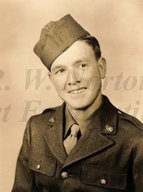
|

|
|
|
|
Thomas was born in Farmerville, Louisiana, one of six children of Tom Pete and Minnie Lee Davidson Williams. The family soon moved to Rayville. His father worked in a sawmill, farmed, and made ties for the railroad. He also made photographs on glass plates to sell. Thomas helped out on the farm with such chores as picking cotton. He quit school after the seventh grade, and as a teenager moved to Grants, New Mexico, where a cousin lived. He "swamped" or helped the driver of a truck. Thomas joined the Civilian Conservation Corps (CCC) in 1939. The CCC took him out to Oregon where he cut wood and cleared fire lanes. He married Jessie Beach on December 22, 1941. They would have five children, five grandchildren, and nine great-grandchildren. Drafted in 1943 and sent to the U.S. Army Air Forces, he took basic training in Atlantic City, New Jersey, and then was sent to radar school at Drew Field in Tampa, Florida. He spent nine months at San Clemente, California manning radar facilities. He recalls the warm reception local citizens gave service personnel. "Those California people treated you just like a king," he says. "If you were in a place to eat lunch you couldn't pay for it." Thomas eventually was sent overseas to the Philippines where he joined the 169th Signal Airborne Battalion. He went on to Leyte where he watched the radar screen for enemy aircraft and called in updates to a nearby airfield. "You could hear them crank up right after we called them in," he says. He went into the occupation of Japan at Yokohama, and then was sent to Yokota. "We just waited. That's all we did was just waited," he says. "I had enough points to come home. We were just waiting on transportation." He returned to America at the end of November of 1945 on the USS Lexington. "I had my discharge in my hand the twenty-second of December," he recalls of leaving service at Camp Fannin near Tyler, Texas. He tried to farm in Louisiana, and then worked as a mechanic in a mine in Leadville, Colorado, for three years. Returning to Louisiana, he worked as an automobile mechanic for most of his career. |


